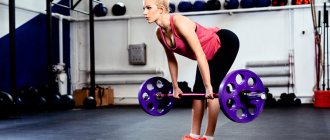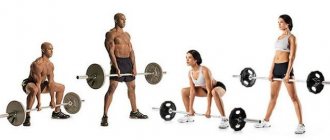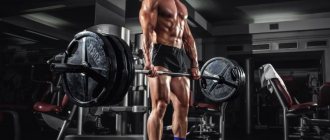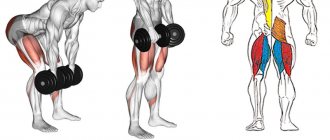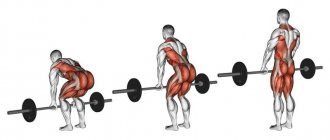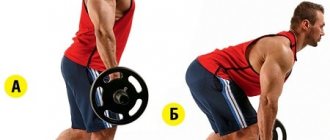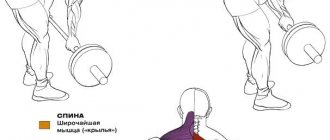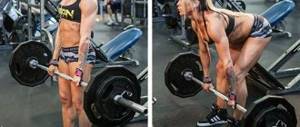General information about deadlifts
There are several types (options) of rods:
- Classic deadlift (builder)
- Deadlift (aka Romanian)
- Deadlift in the “sumo” style (aka lifter’s)
- Trap bar deadlift
Classic deadlift - performed with narrow-medium (for comfort) legs.
I mean that the legs are not placed wide (as in a sumo-style deadlift), here the legs are conditionally narrow (but this does not mean that they are almost next to each other, according to the athlete’s convenience), hands are shoulder-width apart, the bar touches the shin (in front) .
In general, here is a drawing of a classic deadlift below:
Classic deadlift
Deadlift (aka Romanian) is a deadlift with straight legs.
Those. The main difference from classical deadlifts and other types of deadlifts is that here athletes perform deadlifts with almost straight legs, i.e. I want to say that the athlete does not bend his knees (as in other deadlifts), here he specifically works with almost straight legs.
Please note that the deadlift is not performed with 100% straight legs; they are slightly (slightly) bent (very slightly) due to their anatomical features.
Most often, this exercise is performed by girls to work the buttocks and the back of the thigh (femoral biceps), as well as by bodybuilders, again to work the hamstrings.
In general, this exercise is not suitable for setting records... you can’t take particularly heavy weight here, because it’s easy to get injured. In general, see below the picture of the dead (Romanian) draft:
Deadlift (aka Romanian)
A sumo-style deadlift (also known as a lifter's) is when an athlete performs a deadlift in principle as usual, but the stance of the legs is not narrow (as in a classic deadlift), but wide.
Those. the socks are turned out and practically touch the plates from the barbell.
This is a guideline (see for convenience) and the hands holding the bar are not shoulder-width apart, but narrowly (as before the hands, i.e., it won’t be possible to hold the bar shoulder-width apart, because the legs will get in the way, that’s why it’s narrow).
Most often, this type of deadlift is used by powerlifters in competitions (because this technique allows you to lift more weight). Anyway, see the photo of the sumo deadlift below:
Deadlift in the “SUMO” style (aka lifter’s)
The “trap bar” deadlift is not a deadlift of an Olympic barbell (i.e., a regular straight bar), it is a row of a diamond-shaped bar, which has parallel grip handles inside the two bars.
Those. the athlete stands inside this diamond and grabs the handles with a parallel grip (and not as usual).
Due to this, the athlete pulls the weight more vertically compared to conventional rows (those that use a regular bar). I once performed on such a device, I want to say that it is much... much easier to keep your back straight than with conventional rows.
In general, here is a photo of the trap bar:
Trap bar deadlift
Reviews
Some athletes note that deadlifting has helped solve back problems. Especially with aching pain in the lower back. In this case, training should begin without using weights, and build up the technique. After a while (about six months), the muscles become stronger and the pain goes away.
A number of athletes, among all types of exercise, prefer the sumo deadlift. Thanks to her, they managed to pump up the body and build the correct proportions.
For people with problems with knee joints, deadlifting is also useful. It is difficult for them to do squats and lunges, and the straight leg exercise helps keep the muscles of the buttocks and hamstrings in good shape. To do this, you need to train with minimal weights and strictly control the technique and range of movements.
Deadlift technique
Now I am describing the technique of performing the classic deadlift... But the differences from other deadlifts are minimal. Those. I want to say that in all types of deadlifts there will be the same similar actions, only slight differences.
First, you need to approach the implement (bar) with which you will be working. First of all, if the bar (barbell) is lying on the floor, you will need to take the correct grip on the bar (hold) and place your feet correctly. These are the initial steps.
Grab the bar with an overhand grip shoulder-width apart (remember the classic deadlift, the grip is not wide and not too narrow, it is medium, for convenience), the grip should be strong, i.e. you must hold the bar firmly with your hands so that it does not fall out during the exercise.
Ps at the initial stage this will be enough. However, in the future, when you learn to perform the exercise technically (ideally correctly), you will add weight (a lot of weight) and then most likely difficulties will begin with holding the barbell, so a little advice: take it either with an opposite grip (this is when your palms are located in different directions relative to each other to a friend) or use straps (they help a lot), but the grip force in this case will not work because the straps make the work easier.
Here's what straps are and how to wrap them around the bar (instructions):
Instructions on how to wrap straps around a barbell
And here is a picture showing what a different grip is:
A drawing showing what a grip is
Ps I used a different grip before, and felt fine)), see for yourself how convenient it is.
If you have strong hands and you smell normally, i.e. If you can hold a lot of weight, then work as at the very beginning (using a classic overhand grip without anything).
Now about the placement of the feet. Everything is simple here, in the classical deadlift the feet are placed shoulder-width apart (for convenience) - but not wide, they are placed widely during the sumo deadlift (but there the grip (holding the barbell) is narrow), because otherwise it won’t work out; the legs will get in the way (that’s why have to take it narrowly).
Okay, we're positioned correctly near the bar. Use the correct grip and place your feet correctly. What's next? And then the movement itself begins, you need to straighten up.
But, before straightening up, you need to tense your lower back muscles, bend your back (straighten it) and bend in the lumbar region, straighten your chest and shoulders, + look (your head looks straight ahead), not down, not up, not somewhere to the side, strictly forward onto the mirror.
After all these actions, you can straighten up. But remember, when doing the exercise, do not round your back under any circumstances. Rounding your back while performing this exercise with a heavy weight will inevitably lead to back injury.
Deadlift: Back Correctly and Incorrectly
What muscles work in the deadlift?
The deadlift is an absolute record holder for the number of muscles involved in the work.
The barbell row simultaneously involves over 400 muscles. This is approximately 70% of the muscles of the entire body!
The main muscle groups that perform the movement:
- Back (traps, lats, lower back)
- Legs (quadriceps and hamstrings)
- Gluteal muscles
The forearms, abs and lower legs take an active part in the movement.
In addition to them, small stabilizer muscles are also involved in the work.
Depending on the type of deadlift, you can shift the emphasis to a certain muscle group.
For example, the classic deadlift evenly distributes the load on the muscles of the back and legs, the Romanian deadlift works more on the hamstrings and lower back, and the sumo style includes the inner thighs and buttocks.
How to lower the barbell down?
When you lower the bar down (to the floor, as it were), you should slightly bend your knees and at the same time move your pelvis back, but your knees should not bend too much, because it will look like a squat.
This shouldn't happen. When lowering, you slightly bend your knees so that the bar moves calmly without hitting your knees + at the same time as you bend your knees, you move your pelvis back and lower the bar along your legs. That's all.
Your arms should be straight. The deflection in the lower back remains.
Once you reach the bottom point, pull the barbell up, rising from the bottom point.
This is what the full movement (motion mechanics) of a deadlift looks like: (the only thing wrong with this picture is the position of the head (gaze), it should be straight forward, not down or up)
Deadlift: all phases of movement
Yugifted has a video on how to perform deadlifts, if it’s hard for you to understand my thoughts, then what I recommend, look at how to do it correctly in practice: (see video below)
Common Mistakes
The most common and dangerous mistakes when performing deadlifts with a barbell:
- Arching or arching of the back.
- Legs too wide.
- Arching the back or bending back at the top point or in the starting position.
- The grip of the barbell is too wide and the elbows are spread out to the sides.
- Using weights that are too heavy for a person's current shape.
The most dangerous technical errors are clearly shown in the photo:
The main mistakes athletes make when performing classic deadlifts
Mistake #1. Very, very, and once again, a lot of mistakes are made when performing deadlifts.
If it is still somehow permissible for beginners at the initial stage (with an empty bar) in order to learn, then for more advanced athletes who work with weight it is not permissible.
And I often see this and that, people don’t know how to perform this movement correctly, but they’ve already put on weight. Believing the more the better! No no and one more time no!!! It is not right.
You need to hone the mechanics of the movement to perfection, and then start adding weights.
This is the main mistake most people make.
Mistake #2. Rounding the back. A nightmare!!!! This should under no circumstances be done. No way!!!
The back should be flat (bent in the lower back), there should be no rounding, otherwise there will be an injury.
With an empty bar (when it's easy) there will be no injury, but just adding weight will immediately cause injury. I guarantee!!! This is why I say that you need to thoroughly study the mechanics of the movement, and then start working with weights.
Mistake #3. For many people, the bar does not go along the legs (as if down along the legs), but goes forward. I often see this picture. This is also wrong!!! The bar should go down along your legs, it should not come forward.
Mistake #4. When you begin to lower the barbell down (along your legs), you quickly bend your legs (as if squatting).
This is also wrong!!! You can't do that. I repeat, the bar goes along the legs (it seems to gradually fall down, and your butt moves back). And for some, it turns out that they lower the barbell and, as it were, squat with it.
Those. you bend your knees strongly, you need to feel this movement, the bar should go along your legs and your knees should bend slightly so that it passes, but for you (such people) your knees do not bend slightly, but bend strongly and you get something like squats .
Mistake #5. Many people have seen plenty of big guys who tilt their body back at the top point of their movement. It’s as if there is too much deflection of the body at the top point. And they start repeating after them...
This is also not right, you don’t need to do this!!!! Those who do this, they do it for competitions (the judges will either count or not count the lift, this is important for them), you don’t need to do this, you can get injured. If you think that this slope at the top gives something (in terms of muscle growth), then no! This is wrong)).
Okay, we've covered the classic deadlift in detail. But, as I already said, the differences from other rods are minimal. Those. I want to say that in all types of thrusts there will be the same similar actions, only slight differences which we will talk about now.
How is the classic deadlift different from the sumo deadlift?
Classic and sumo deadlifts
The main difference between the classic deadlift and the sumo deadlift is the placement of the legs and the width of the grip.
Those. as we already know, in the classical deadlift the legs are positioned relatively narrow and the grip is shoulder-width apart (they move slightly away from the legs so as not to interfere), but in the sumo deadlift the legs are positioned wide (the toes are turned out and practically touch the plates from the bar) and the grip is this is not shoulder-width apart (like the classic deadlift), but relatively narrow (so that the legs do not interfere with the arms).
As for the technique of performing the exercise itself, i.e. The differences between the classical deadlift and the sumo deadlift are minimal. In reality, all the same actions (only the position of the legs and the width of the grip change), otherwise everything is the same:
- approaching the fretboard
- bend over, place your feet wide (so wide that your toes almost touch the weights on the barbell)
- we sit down to a position so that your arms are straight and you can grab the bar with an overhand grip
- after which we will need to straighten up (insert from the lower position), for this we bend our back (straighten it) and bend in the lumbar region, straighten our chest and shoulders, look (the head looks straight forward), not down, not up, not somewhere to the side, straight forward on the mirror.
- After all these actions, you can straighten up. But remember, when doing the exercise, do not round your back under any circumstances. Rounding your back while performing this exercise with a heavy weight will inevitably lead to back injury.
That's all. As I already said, the differences are minimal, but just in case, I was not too lazy to repeat all the necessary steps again (slightly adjusting them). Ok, we've sorted that out, let's move on.
Health risks
Deadlift is an exercise that is both effective and dangerous if you do not follow the correct technique and force the growth of the weight.
Therefore, technique, technique and technique again!
Ideally, a personal trainer will help you master this exercise.
People who already have problems with the spine should be wary of the deadlift.
The slightest pain or discomfort in the back is the reason why you should refuse to perform this exercise and look for other alternatives.


